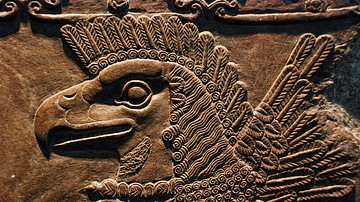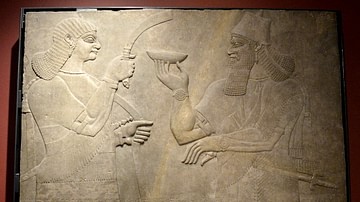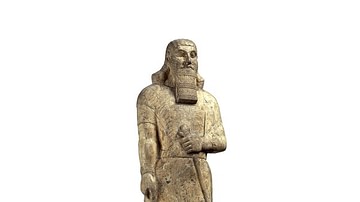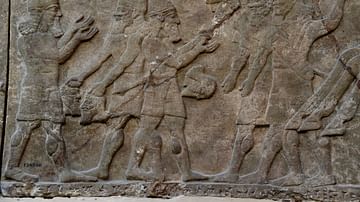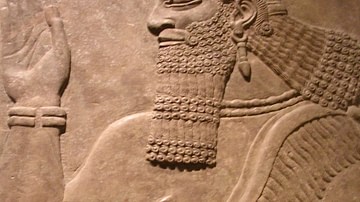When he came to the throne in 884 BCE, Ashurnasirpal II had to attend to revolts which broke out across the empire. He ruthlessly put down all rebellions, destroyed the rebel cities and, as a warning to others, impaled, burned, and flayed alive any who had opposed him. He fortified and strengthened his borders and then expanded them through campaigns that filled the royal treasury with booty. Having secured his empire, Ashurnasirpal II turned his attention to his capital at Ashur, which he renovated (as he also did with Nineveh and many other cities during his reign). Ashur was among the most prosperous of the Assyrian cities and had been the capital of the Assyrian Empire since the reign of Adad Nirari I (1307-1275 BCE).
Once Ashurnasirpal II had added his own adornments and improvements to the great city, he now felt it was time for a change in its status. The residents of Ashur were proud of their city and of their prestige as citizens of the capital. It has been proposed by a number of scholars that Ashurnasirpal II wanted a completely new city with a new population that he could call his own in order to elevate his name above his predecessors and rule over a populace devoted wholly to him, rather than devotion divided between their king and their city. He chose the ruins of the city of Kalhu (also known as Caleh, Calah, and, later, Nimrud) which had been built under the reign of Shalmaneser I (1274-1245 BCE) but had been neglected and, in time, became dilapidated. Ashurnasirpal II ordered it completely re-built, including a new grand palace, which would now become the capital of the Assyrian Empire instead of Ashur.
The city and palace were completed by 879 BCE, at which point Ashurnasirpal II threw a grand inaugural party attended by 69,574 people and lasting ten days. To commemorate this event, and the completion of his new capital city, he ordered a stele to be engraved recording his grand building project and the inaugural party. This stele was discovered in the ruins of Kalhu in 1951 CE. The historian James B. Pritchard writes:
On a sandstone block placed near the doorway to the throne room of the palace of Ashurnasirpal in Calah was found in 1951 a figural representation with an inscription (total: 154 lines) in an unusual arrangement. The upper part of the stone shows the king in a square recess, flanked by inscribed columns, under an awkwardly arranged row of divine symbols. The text, apart from its stereotyped titulary and historical summary, is mainly concerned with the building of the new capital Calah, the royal garden, and the festival in celebration of the opening of the royal palace (99).
Kalhu continued as the capital of the Assyrian Empire from its inauguration in 879 BCE until Sargon II moved the capital to his new city of Dur-Sharrukin in 606 BCE. After Sargon II's death in 605 BCE, the capital was moved by his son Sennacherib to Nineveh, where it remained until the fall of the Assyrian Empire. Kalhu continued to be an important city to the Assyrian rulers even after it was no longer the capital. Later kings of the empire stayed in the palace when they were visiting the region, and the city continued as an important administrative center. In 612 BCE Kalhu, Ashur, Nineveh, and all the great cities of the Assyrians were sacked and burned by invading coalitions of Medes, Babylonians, Persians, and others. The great doors sheathed in bronze and the cedar beams of the palace and the temples which Ashurnasirpal II boasts of building would all have gone up in flames in the conflagrations of 612 BCE along with the orchards he had planted on the outskirts of the city and the gardens he makes mention of.
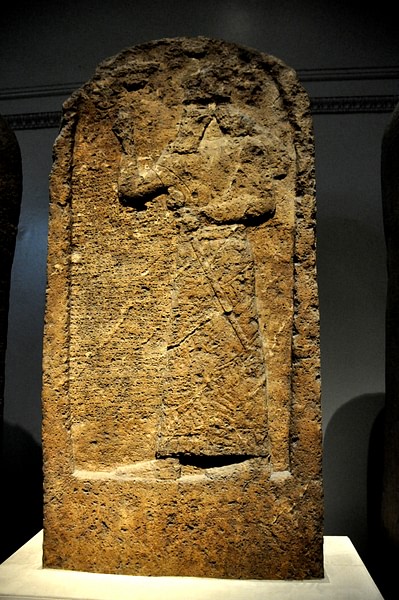
The following is the transcription of that sandstone block Pritchard describes above, which has come to be known as The Banquet Stele of Ashurnasirpal II. It is here given complete following the edition prepared by James B. Pritchard and included in his work The Ancient Near East, Volume II, a book of primary documents from the Near East.
i.
This is the palace of Ashurnasirpal, the high priest of Ashur, chosen by Enlil and Ninurta, the favorite of Anu and of Dagan who is destruction personified among all the great gods – the legitimate king, the king of the world, the king of Assyria, son of Tukulti-Ninurta, great king, legitimate king, king of the world, king of Assyria who was the son of Adad-Nirari, likewise great king, legitimate king, king of the world and king of Assyria – the heroic warrior who always acts upon trust-inspiring signs given by his lord Ashur and therefore has no rival among the rulers of the four quarters of the world; the shepherd of all mortals, not afraid of battle but on onrushing flood which brooks no resistance; the king who subdues the unsubmissive and rules over all mankind; the king who always acts upon trust-inspiring signs given by his lords, the great gods, and therefore has personally conquered all the countries; who has acquired dominion over the mountain regions and received their tribute; he takes hostages, triumphs over all the countries from beyond the Tigris to the Lebanon and the Great Sea, he has brought into submission the entire country of Laqe and the region of Suhu as far as the town of Rapiqu; personally he conquered the region from the source of the Subnat River to Urartu.
I returned to the territory of my own country the regions of the pass which leads to the country Kirrure as far as Gilsani, from beyond the Lower Zab River to the town of Til-bari which is upstream of the land of Zamua – from Til-sha-abtani to Til-sha-sabtani – also Hirimu and Harrutu in the fortified border region of Babylonia (Karduniash). I listed as inhabitants of my own country the people living from the pass of Mt. Babite to the land of Hashmar.
Ashur, the Great Lord, has chosen me and made a pronouncement concerning my world rule with his own holy mouth as follows: Ashurnasirpal is the king whose fame is power!
I took over again the city of Calah in that wisdom of mine, the knowledge which Ea, the king of the subterranean waters, has bestowed upon me, I removed the old hill of rubble; I dug down to the water level; I heaped up a new terrace measuring from the water level to the upper edge 120 layers of bricks; upon that I erected as my royal seat and for my personal enjoyment7 beautiful halls roofed with boxwood, Magan-ash, cedar, cypress, terebinth, tarpi'u, and mehru beams; I sheathed doors made of cedar, cypress, juniper, boxwood and Magan-ash with bands of bronze; I hung them in their doorways; I surrounded them, the doors, with decorative bronze bolts; to proclaim my heroic deeds I painted on their (the palaces) walls with vivid blue paint how I have marched across the mountain ranges, the foreign countries and the seas, my conquests in all countries; I had lapis lazuli colored glazed bricks made and set them in the wall above the gates. I brought in people from the countries over which I rule, those who were conquered by me personally, that is from the country Suhi those of the town […] from the entire land of Samua, the countries Bit-Samani and Kirrure, the town of Sirqu which is across the Euphrates, and many inhabitants of Laqe, of Syria and who are subjects of Lubarna, the ruler of Hattina; I settled them therein the city of Calah.
I dug a canal from the Upper Zab River; I cut for this purpose straight through the mountains; I called it Patti-hegalli (“Channel of Abundance”); I provided the lowlands along the Tigris with irrigation; I planted orchards at the city's outskirts, with all sorts of fruit trees.
I pressed grapes and offered them as first fruits in a libation to my lord Ashur and to all the sanctuaries of my country. I then dedicated that city to my lord Ashur.
I collected and planted in my garden, from the countries through which I marched and the mountains which I crossed, the trees and plants raised from seeds from wherever I discovered them, such as: cedars, cypresses, simmesallu-perfume trees, burasu-junipers, myrrh-producing trees, dapranu-junipers, nut bearing trees, date palms, ebony, Magan-ash, olive trees, tamarind, oaks, tarpi'u-terebinth trees, luddu-nut-bearing trees, pistachio and cornel trees, mehru-trees, se.mur-trees, tijatu-trees, Kanish oaks, willows, sadanu-trees, pomegranates, plum trees, fir trees, ingirasu-trees, kamesseru-pear trees, supur-gillu-bearing trees, fig trees, grape vines, angasu-pear trees, aromatic sumlalu-trees, titip-trees, hip/butu-trees, zansaliqqu-trees, swamp apple trees, hambuququ-trees, nuhurtu-trees, ursinu-trees, resinous kanaktu-trees [and others]. In the gardens in Calah they vied with each other in fragrance; the paths in the gardens were well kept, the irrigation weirs distributed the water evenly; its pomegranates glow in the pleasure garden like the stars in the sky, they are interwoven like grapes on the vine […] in the pleasure garden […] in the garden of happiness flourished like cedar trees.
ii.
I erected in Calah, the center of my overlordship, temples such as those of Enlil and Ninurta which did not exist there before; I rebuilt in it the following temples of the great gods: the temples of Ea-sharru and Damkina, of Adad and Shala, of Gula, Sin, Nabu, Belet-nathi, Sibittu and of Ishtar-kidmuri. In them I established the sacred pedestals of these, my divine lords. I decorated them splendidly; I roofed them with cedar beams, made large cedar doors, sheathed them with bands of bronze, placed them in their doorways. I placed figural representations made of shining bronze in their doorways. I made the images of their great godheads sumptuous with red gold and shining stone. I presented them with golden jewelry and many other precious objects which I had won as booty.
I lined the inner shrine of my lord Ninurta with gold and lapis lazuli, I placed right and left of it objects made of bronze, I placed at his pedestal fierce usumgallu-dragons of gold. I performed his festival in the months Shabatu and Ululu. I arranged for them the materials needed for scatter and incense offerings so that his festival in Shabatu should be one of great display. I fashioned a statue of myself as king in the likeness of my own features out of red gold and polished stones and placed it before my lord Ninurta.
I organized the abandoned towns which during the rule of my fathers had become hills of rubble, and had many people settle therein; I rebuilt the old palaces across my entire country in due splendour; I stored in them barley and straw.
Ninurta and Palil, who love me as their high priest, handed over to me all the wild animals and ordered me to hunt them. I killed 450 big lions; I killed 390 wild bulls from my open chariots in direct assault as befits a ruler; I cut off the heads of 200 ostriches as if they were caged birds; I caught 30 elephants in pitfalls. I caught 50 wild bulls, 140 ostriches, and 20 big lions with my own [hands] and stave.
iii.
I received five live elephants as tribute from the governor of Suhu, the Middle Euphrates Region, and the governor of Lubda (South East Assyria toward Babylonia); they used to travel with me on my campaigns.
I organized herds of wild bulls, lions, ostriches, and male and female monkeys and had them breed like flocks of domestic animals.
I added land to the land of Assyria, many people to its people.
When Ashurnasirpal, king of Assyria, inaugurated the palace in Calah, a palace of joy, and erected with great ingenuity, he invited into it Ashur, the great lord and the gods of his entire country. He prepared a banquet of 1,000 fattened head of cattle, 1,000 calves, 10,000 stable sheep, 15, 000 lambs – for my lady Ishtar alone 200 head of cattle and 1,000 sihhu-sheep – 1,000 spring lambs, 500 stags, 500 gazelles, 1,000 ducks, 500 geese, 5000 kurku-geese, 1,000 mesuku-birds, 1,000 qaribu-birds, 10,000 doves, 10,000 sukanunu-doves, 10,000 other, assorted, small birds, 10,000 assorted fish, 10,000jerboa, 10,000 assorted eggs, 10,000 loaves of bread, 10,000 jars of beer, 10,000 skins with wine, 10,000 pointed bottom vessels with su'u-seeds in sesame oil, 10,000 small pots with sarhu-condiment, 1,000 wooden crates with vegetables, 300containers with oil, 300 containers with salted seeds, 300 containers with mixed raqqute-plants, 100 with kudimmu-spice, 100 containers with […] 100 containers with parched barley, 100 containers with green abahsinnu-stalks, 100 containers with fine mixed beer, 100 pomegranates, 100 bunches of grapes, 100 mixed zamru-fruits, 100 pistachio cones, 100 with the fruits of the susi-tree, 100 with garlic, 100 with onions, 100 with kuniphu seeds, 100 with the […] of turnips, 100 with hinhinnu-spice, 100 with budu-spice, 100 with honey, 100 with rendered butter, 100 with roasted […] barley, 100 with roasted su'u-seeds, 100 with karkartu-plants, 100 with fruits of the ti'atu-tree, 100 with kasu-plants, 100 with milk, 100 with cheese, 100 jars with `mixture', 100 with pickled arsuppu-grain, ten homer of shelled luddu-nuts, ten homer of shelled pistachio nuts, ten homer of fruits of the susu-tree, ten homer of fruits of the kabba-ququ-tree, ten homer of dates, ten homer of the fruits of the titip tree, ten homer of cumin, ten honer of sahhunu, ten homer of urianu, ten homer of andahsu-bulbs, then homer of sisanibbe-plants, (iv) ten homer of the fruits of the simburu-tree, ten homer of thyme, ten homer of perfumed oil, ten homer of sweet smelling matters, ten homer of […] ten homer of the fruits of the nasubu-tree, homer of […], ten homer of the fruits of the nasubu-tree, ten homer of zimzimmu-onions, ten homer of olives.
When I inaugurated the palace at Calah I treated for ten days with food and drink 47,074 persons, men and women, who were bid to come from across my entire country, also 5,000 important persons, delegates from the country Suhu, from Hindana, Hattina, Hatti, Tyre, Sidon, Gurguma, Malida, Hubushka, Gilzana, Kuma and Mushashir, also 16,000 inhabitants of Calah from all ways of life, 1,500 officials of all my palaces, altogether 69,574 invited guests from all the mentioned countries including the people of Calah; I furthermore provided them with the means to clean and anoint themselves. I did them due honors and sent them back, healthy and happy, to their countries.

